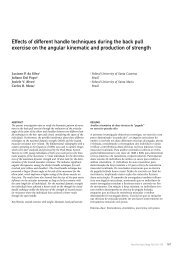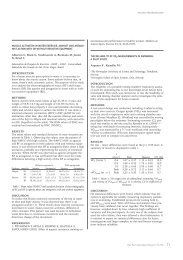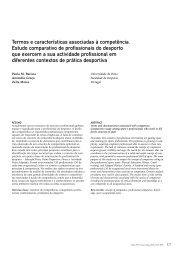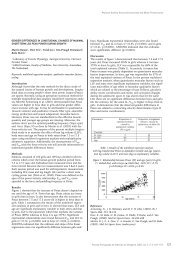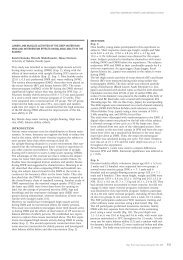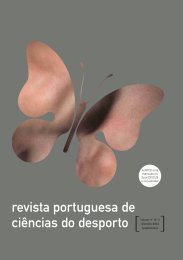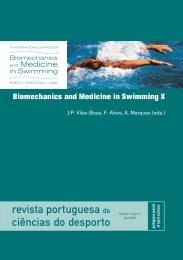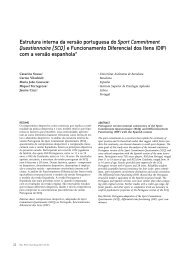download PDF - Faculdade de Desporto da Universidade do Porto
download PDF - Faculdade de Desporto da Universidade do Porto
download PDF - Faculdade de Desporto da Universidade do Porto
You also want an ePaper? Increase the reach of your titles
YUMPU automatically turns print PDFs into web optimized ePapers that Google loves.
168<br />
Larissa Braga, Maria Mello, Fúlvia Mancha<strong>do</strong>, Claudio Gobatto<br />
REFERÊNCIAS BIBLIOGRÁFICAS<br />
1. Araujo PE, Mayer J (1973). Activity increase associated<br />
with obesity induced by monosodium glutamate in mice.<br />
Am J Physiol 225: 764-765.<br />
2. Ballor DL, Phoehlman ET (1992). Resting metabolic rate<br />
and coronary-heart-disease risk factors in aerobically and<br />
resistance-trained women. Am J Clin Nutr 56: 968-974.<br />
3. Brau L (1997). Regulation of glycogen synthase and phosphorylase<br />
during recovery from high-intensity exercise in<br />
rat. Biochem J 322: 303-308.<br />
4. Caputo FA, Ali SF, Wolff GL, Scallet AC (1996). Neonatal<br />
MSG reduces hypothalamic DA, β-en<strong>do</strong>rphin, and <strong>de</strong>lays<br />
weight gain in genetically obese (A viable yellow /a) mice.<br />
Pharmacol Biochem Behav 53: 425-432.<br />
5. Cheng B, Karamizral O, Noales, TD, Dennis, SC, Lambert<br />
EV (1997). Time course of the effects of a high-fat diet<br />
and voluntary exercise on muscle enzyme activity in Long-<br />
Evans rats. Physiol & Behav 61: 701-705.<br />
6. Couto GEC (1995). Efeito <strong>do</strong> exercício físico contínuo<br />
sobre o metabolismo lipídico <strong>de</strong> ratos torna<strong>do</strong>s obesos<br />
pelo tratamento com glutamato monossódico (MSG).<br />
Dissertação. Universi<strong>da</strong><strong>de</strong> Fe<strong>de</strong>ral <strong>de</strong> São Paulo. São Paulo.<br />
7. Damaso AR (2001). Nutrição e exercício na prevenção <strong>de</strong> <strong>do</strong>enças.<br />
São Paulo: MEDSI.<br />
8. Dela F, Ploug T, Handberg A, Petersen LN, Larsen JJ,<br />
Mikines KJ, Galbo H (1994). Physical training increases<br />
muscle GLUT4 protein and mRNA in patients with<br />
NIDDM. Diabetes 43: 862-865.<br />
9. Djazayery A, Miller DS, Stock MJ (1979). Energy balances<br />
in obese mice. Nutr Metab 23: 357-367.<br />
10. Dolnikoff M, Martín-Hi<strong>da</strong>lgo A, Macha<strong>do</strong> UF, Lima FB,<br />
Herrera E (2001). Decreased lipolysis and enhanced glycerol<br />
and glucose utilization by adipose tissue prior to <strong>de</strong>velopment<br />
of obesity in monosodium glutamate (MSG) treated-rats.<br />
Int J Obes 25: 426-433.<br />
11. Dubois B, Jilles KA, Hamiltom JK, Re<strong>de</strong>rs PA (1956).<br />
Colorimetric method for <strong>de</strong>termination of sugar and related<br />
substances. Analytical Chem 28: 350-356.<br />
12. Forbes GB (1992). Exercise and lean weight: the influence<br />
of body weight. Nutr Rev 50: 157-261.<br />
13. Gobatto CA, Mello MAR, Souza CT, Ribeiro IA (2002).<br />
Monosodium glutamate obese rat as mo<strong>de</strong>l for the study<br />
of exercise in obesity. Res Commun Mol Pathol Pharmacol<br />
111: 89-102.<br />
14. Henriksen EJ (1996). Role of glucose transport in glycogen<br />
supercompensation in reweighted rat skeletal muscle. Am J<br />
Physiol 80: 1540-1546.<br />
15. Houmard JA, Shinebarger MH, Dolan PL, Leggett-Frazier<br />
N, Bruner RK, Mccammon MR, Israel RG, Dohm GL<br />
(1993). Exercise training increases GLUT-4 protein concentration<br />
in previously se<strong>de</strong>ntary middle-age men. Am J<br />
Physiol 264: E896-E901.<br />
16. Hughes VA, Fiatarone MA, Fielding RA, Kahn BB, Ferrara<br />
CM, Shepherd P, Fisher EC, Wolfe RR, Elahi D, Evans WJ<br />
(1993). Exercise increases muscle GLUT-4 levels and insulin<br />
action in subjects with impaired glucose tolerance. Am<br />
J Physiol 264: E855-E862.<br />
17. Hunter GR, Weinsier RL, Bamman MM, Larson DE<br />
(1998). A role for high intensity exercise on energy balance<br />
and weight control. Int J Obes Relat Metab Disor<strong>de</strong>rs 6:<br />
489-493.<br />
Rev Port Cien Desp 6(2) 160–169<br />
18. Imbeault P, Saint-Pierre S, Alméras N, Tremblay A (1997).<br />
Acute effects of exercise on energy intake and feeding<br />
behavior. Brit J Nutr 77: 511-521.<br />
19. Jacobs I., Esbjornsson M, Sylve C, Holm I, Jansson E<br />
(1987). Sprint training effects on muscle myoglobin, encimes,<br />
fiber types, and blood lactate. Med Sci Sports Exerc 19:<br />
368-374.<br />
20. James DE, Kraegen EW, Chisholm D (1984). Effect of<br />
exercise training on whole-body insulin sensitivity and responsiveness.<br />
J Appl Physiol 56: 1217-1222.<br />
21. Jéquier E, Tappy L (1999). Regulation of body weight in<br />
humans. Physiol Rev 79: 451-480.<br />
22. Lladó I, Pons A, Palou A (1997). Fatty acid composition of<br />
Brown adipose tissue in dietary obese rats. Biochem Mol<br />
Biol Int 43: 1129-1136.<br />
23. Lowry OH, Rosebrough NF, Farr AL, Ran<strong>da</strong>l RJ (1951).<br />
Protein measurement with the folin phenol reagent. J Bio<br />
Chem 193: 265-275.<br />
24. Macha<strong>do</strong> UFE, Saito M (1995). The effect of adipose cell<br />
size on the measurement of GLUT-4 in white adipose tissue<br />
of obese mice. Br J Med and Biol Res 28: 369-376.<br />
25. Marmo MR, Dolnikoff MS, Kettelhut IC, Matsushita DM,<br />
Hell NS, Lima FB (1994). Neonatal monosodium glutamate<br />
treatment increases epidymal adipose tissue sensitivuty to<br />
insulin there-month old rats. Br J Med Biol Res 27: 1249-1253.<br />
26. Mello MAR, Souza CT, Braga LR, Santos JW, Ribeiro IA,<br />
Gobatto C (2001). A.Glucose tolerance and insulin action<br />
in monosodium Glutamate (MSG) obese exercise-trained<br />
rats. Physiol Chem Phys and Med NMR 33: 63-71.<br />
27. Moss D, Ma A, Cameron DP (1985). Defective thermoregulatory<br />
thermogeneses in monosodium glutamate – induced<br />
obesity in mice. Metabolism 34: 626-630.<br />
28. Nakai N (1996). Exercise training prevents maturationinduced<br />
<strong>de</strong>crease in insulin sensitivity. J Appl Physiol 80:<br />
1963-1967.<br />
29. Nicklas BJ (1997). Effects on endurance exercise on adipose<br />
tissue. Exerc Sports Rev 25: 77-103.<br />
30. Olney JW (1969). Brain lesion, obesity, and other disturbances<br />
in mice treated with monosodium glutamate.<br />
Science 164: 719-721.<br />
31. Pilegaard H, Bangsbo J, Richter EA, Juel C (1994). Lactate<br />
transport studied in sarcolemmal giant vesicles from<br />
human muscle biopsies: relation to training status. J Appl<br />
Physiol 77: 1858-1862.<br />
32. Pi-Sunyer FX, Woo R (1995). Effect of exercise on food<br />
intake in human subjects. Am J Clin Nutr 42: 983-990.<br />
33. Powers SK, Howley ET, Cox R (1992). A differential catecholamine<br />
response during prolonged exercise and passive<br />
heating. Med Sci Sport Exerc 14: 453-459.<br />
34. Ribeiro EB, Nascimento CMO, Andra<strong>de</strong> IS, Hirata AE,<br />
Dolnikoff MS (1997). Hormonal and metabolic a<strong>da</strong>ptations<br />
to fasting in monosodium glutamate-obese rats. J<br />
Comp. Physiol B 167: 430-437.<br />
35. Scalfani A (1984). Animal mo<strong>de</strong>ls of obesity: classification<br />
and characterization. Int J Obes 8: 491-508.<br />
36. Silva MP, Marcon<strong>de</strong>s MCG, Mello MAR (1999). Exercício<br />
aeróbio e anaeróbio: efeitos sobre a gordura sérica e tecidual<br />
<strong>de</strong> ratos alimenta<strong>do</strong>s com dieta hiperlipídica. Rev Bras<br />
Ativ Fís Saú<strong>de</strong> 4: 43-56.<br />
37. Sjodin AM, Forslund AH, Westerterp KR, An<strong>de</strong>rsson AB,<br />
Forslund JM, Hambraeus LM (1996). The influence of<br />
physucal activity on BMR. Med Sci Sports Exerc 28: 85-91.



